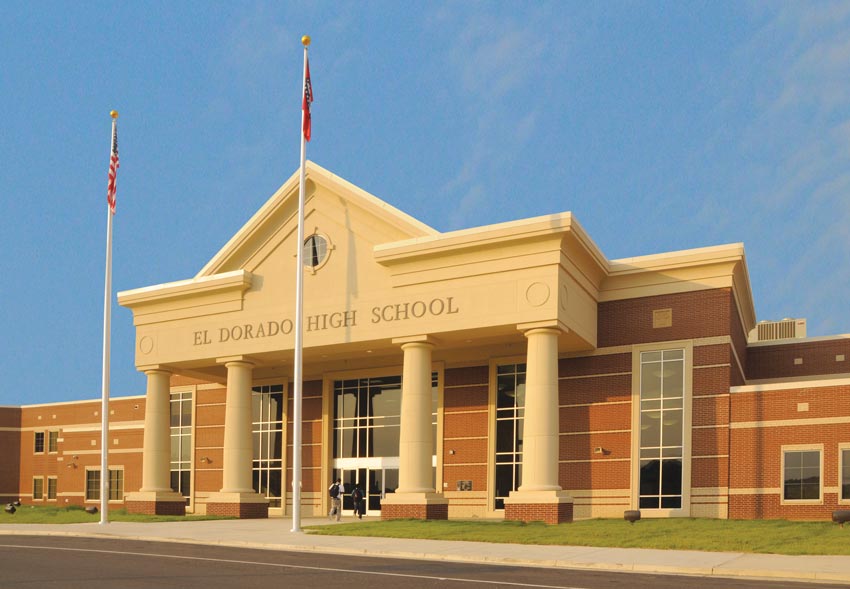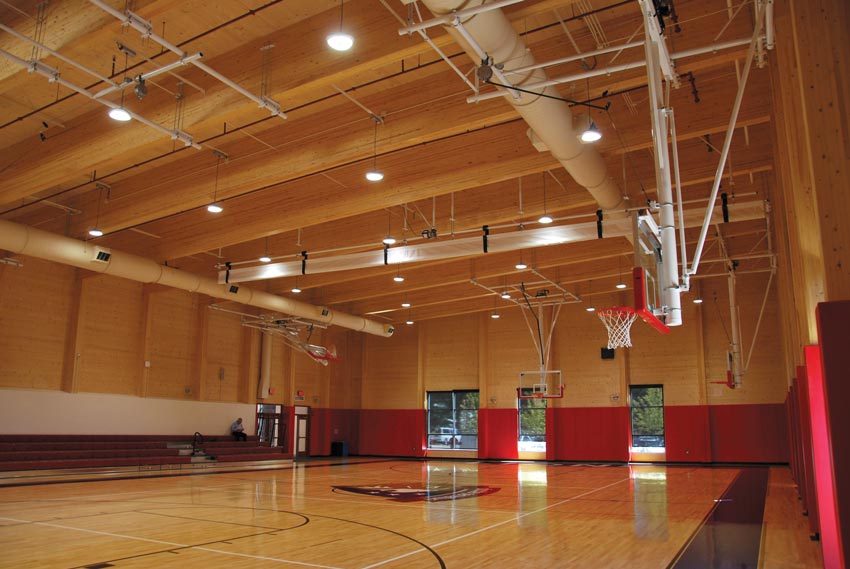Designing Modern Wood Schools
Code Provisions for Height and Area Increases
For all but Type I buildings, the square footage shown in Figure 3 is clearly much less than the average school sizes stated above. These are base heights and areas, and numerous code provisions exist for increases beyond those amounts. In the context of a wood-frame school, for example, designers may utilize the following:
Sprinklers: The requirement to include an NFPA 13 sprinkler system is not based on materials or construction type. It is based on occupancy group, occupant load, size of the fire area, and other occupant-specific criteria. Per IBC Section 903.2, an NFPA 13 sprinkler system is required throughout all educational and assembly occupancies where the fire area exceeds 12,000 square feet—which includes the vast majority of school construction. Use of an NFPA 13 sprinkler system allows designers to significantly increase the height and area of these facilities.
- Per IBC Tables 504.3 and 504.4, buildings equipped throughout with an NFPA 13 sprinkler system can add one story and 20 feet to the base stories and heights in IBC Table 503.
- Per IBC Table 506.2 and Section 506.2, buildings equipped throughout with an NFPA 13 sprinkler system can add 200–300 percent to the base floor areas in Table 503. For a single-story building, the base area can be multiplied by four. For a multistory building, the base area can be multiplied by three.
- The story and height increases are permitted to be used concurrently with the area increase per IBC Tables 504.3, 504.4 and 506.2.
Open frontage: Open space around a building, such as a parking lot or major roadway, provides firefighting access to multiple sides of the structure. If more than 25 percent of the building’s perimeter is open for a minimum of 20 feet, IBC Section 506.3 allows an increase to the unsprinklered floor area in Table 506.2 of up to 75 percent.
The area increases for sprinklers and open frontage are per story. Per IBC Section 506.2.3, a two-story school building’s total area is permitted to be twice the increased area, and a three-story (or taller) school building’s total area is permitted to be three times the increased area. Figure 4 shows the total potential square footage impact for Educational Group E occupancy.
Compared to a Type IIA steel or concrete building, a Type IIIA wood-frame building has the same height limits of four stories and 85 feet. The Type IIIA building offers nearly 90,000 square feet per floor, and more than 176,000 square feet for a two-story building. Even a Type VA structure offers an area of nearly 139,000 square feet for a two-story building, which is larger than many schools.

Source: IBC Tables 504.3, 504.4 and 506.2
With sprinklers and open frontage, Type III and Type V Construction offer ample height and area for most schools.
Unlimited area: Per IBC Section 507.11, a wood-frame school may also qualify for unlimited area—if, for example, the building:
- Has a minimum of 60 feet open frontage around the perimeter
- Is Type IIIA or IV Construction, one story, fully sprinklered, and classified as Educational Group E occupancy
- Is Type III or IV Construction, one story, fully sprinklered, and classified as Assembly Group occupancy (A-4)
- Meets other provisions such as those related to egress
Fire walls: Fire walls are the most restrictive type of wall assembly in terms of their construction and hourly fire-rating requirements. However, they allow areas within a structure to be considered as separate buildings for the purpose of calculating height and area, further increasing the potential size of a project.
The Savings Add Up
Combine the ICC’s estimated cost per square footage from Figure 2 with the average school size and costs from the School Planning & Management report, and a picture emerges of significant cost savings. By switching from a Type IIA steel or concrete school to a Type IIIA wood-frame school, the ICC estimates show a potential 11 percent savings. Now factor in the average school size:
- Elementary school: 80,000 square feet/save $1.7 million
- Middle school: 117,000 square feet/save $2.5 million
- High school: 154,700 square feet/save $3.3 million
For most elementary and middle schools, the average size falls within the maximum allowable by Type VA Construction, bringing the potential savings closer to 22 percent.

Photo: Dennis Ivy; courtesy of WoodWorks
Location: El Dorado, Arkansas
Architect: CADM Architecture
Structural Engineer: Engineering Consultants, Inc.
When the initial steel and masonry design for this 320,000-square-foot, Type IIIA high school came in well over budget, the project team evaluated alternative systems. The intent had always been to utilize exposed heavy timber in select areas. However, by changing approximately 40 percent of the nonexposed structural materials to wood framing, the team was able to save $2.7 million.4










